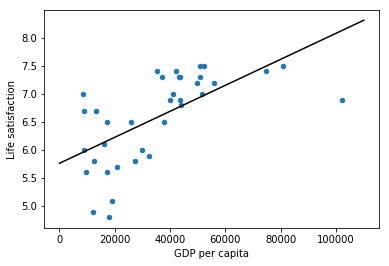Notes : <Hands-on ML with Sklearn & TF> Chapter 1
<Hands-on ML with Sklearn & TF> Chapter 1
- what is ml
- from experience E with respect to some task T and some performance measure P, if its performance on T, as measured by P, improves with experience E.
- what problems to solve
- exist solution but a lot of hand-tuning/rules
- no good solutions using a traditional approach
- fluctuating environment
- get insight about conplex problem and large data
- type
- whether or not trained with human supervision(supervised, unsupervised, semisupervised, reinforcement)
- whether or not learn incrementally on the fly(online, batch)
- whether or not work by simply comparing new data point vs know data point,or instance detect pattern in training data and build a prediction model(instace-based, model-based)
- (un)supervision learning
- supervision : include the desired solution called labels
- classification,K-Nearest Neighbors, Linear Regression, Logistic Regression, SVM, Decision Trees, Random Forests, Neural network
- unsupervision : without labels
- Clustering : k-means, HCA, ecpectation maximization
- Viualization and dimensionality reducation : PCA, kernal PCA, LLE, t-SNE
- Association rule learning : Apriori, Eclat
- semisupervision
- unsupervision --> supervision
- reinforcement : an agent in context
- observe the environment
- select and perform action
- get rewards in return
- supervision : include the desired solution called labels
- batch/online learning
- batch : offline, to known new data need to train a new version from scratch one the full dataset
- online : incremental learning : challenge is bad data
- instance-based/model-based
- instance-based : the system learns the examples by heart, then the generalizes to the new cases using a similarity measure
- model-based : studied the data; select a model; train it on the training data; applied the model to make predictions on new cases
- Challenge
- insufficient quantity of training data
- nonrepresentative training data
- poor-quality data
- irrelevant features : feature selection; feature extraction; creating new feature by gathering new data
- overfitting : regularization -> hyperparameter
- underfitting : powerful model; better feature; reduce construct
- Testing and Validating
- 80% of data for training 20% for testing
- validating : best model and hyperparameter for training set unliking perform as well on new data
- train multiple models with various hyperparameters using training data
- to get generatlization error , select the model and hyperparamaters that perform best on the validation set
- cross-validating : the training set is split into complementary subsets, ans each model is trained against a different conbination of thse subsets and validated against the remain parts.
Example 1-1:
import matplotlib
import matplotlib.pyplot as plt
import numpy as np
import pandas as pd
import sklearn.linear_model #load the data
oecd_bli = pd.read_csv("datasets/lifesat/oecd_bli_2015.csv",thousands=',')
gdp_per_capita = pd.read_csv("datasets/lifesat/gdp_per_capita.csv",thousands=',',delimiter='\t',encoding='latin1',na_values='n/a') #prepare the data
def prepare_country_stats(oecd_bli, gdp_per_capita):
#get the pandas dataframe of GDP per capita and Life satisfaction
oecd_bli = oecd_bli[oecd_bli["INEQUALITY"]=="TOT"]
oecd_bli = oecd_bli.pivot(index="Country", columns="Indicator", values="Value")
gdp_per_capita.rename(columns={"": "GDP per capita"}, inplace=True)
gdp_per_capita.set_index("Country", inplace=True)
full_country_stats = pd.merge(left=oecd_bli, right=gdp_per_capita, left_index=True, right_index=True)
return full_country_stats[["GDP per capita", 'Life satisfaction']] country_stats = prepare_country_stats(oecd_bli, gdp_per_capita)
#regularization remove_indices = [0, 1, 6, 8, 33, 34, 35]
country_stats.to_csv('country_stats.csv',encoding='utf-8')
X = np.c_[country_stats["GDP per capita"]]
Y = np.c_[country_stats["Life satisfaction"]] #Visualize the data
country_stats.plot(kind='scatter',x='GDP per capita',y='Life satisfaction') #Select a linear model
lin_reg_model = sklearn.linear_model.LinearRegression() #Train the model
lin_reg_model.fit(X, Y) #plot Regression model
t0, t1 = lin_reg_model.intercept_[0], lin_reg_model.coef_[0][0]
X = np.linspace(0, 110000, 1000)
plt.plot(X, t0 + t1 * X, "k")
plt.show() #Make a prediction for Cyprus
X_new=[[22587]]
print(lin_reg_model.predict(X_new))

课后练习挺好的
Notes : <Hands-on ML with Sklearn & TF> Chapter 1的更多相关文章
- Notes : <Hands-on ML with Sklearn & TF> Chapter 5
.caret, .dropup > .btn > .caret { border-top-color: #000 !important; } .label { border: 1px so ...
- Notes : <Hands-on ML with Sklearn & TF> Chapter 7
.caret, .dropup > .btn > .caret { border-top-color: #000 !important; } .label { border: 1px so ...
- Notes : <Hands-on ML with Sklearn & TF> Chapter 6
.caret, .dropup > .btn > .caret { border-top-color: #000 !important; } .label { border: 1px so ...
- Notes : <Hands-on ML with Sklearn & TF> Chapter 4
.caret, .dropup > .btn > .caret { border-top-color: #000 !important; } .label { border: 1px so ...
- Notes : <Hands-on ML with Sklearn & TF> Chapter 3
Chapter 3-Classification .caret, .dropup > .btn > .caret { border-top-color: #000 !important; ...
- Book : <Hands-on ML with Sklearn & TF> pdf/epub
非常好的书,最近发现了pdf版本,链接:http://www.finelybook.com/hands-on-machine-learning-with-scikit-learn-and-tensor ...
- H5 Notes:PostMessage Cross-Origin Communication
Javascript中要实现跨域通信,主要有window.name,jsonp,document.domain,cors等方法.不过在H5中有一种新的方法postMessage可以安全实现跨域通信,并 ...
- H5 Notes:Navigator Geolocation
H5的地理位置API可以帮助我们来获取用户的地理位置,经纬度.海拔等,因此我们可以利用该API做天气应用.地图服务等. Geolocation对象是我们获取地理位置用到的对象. 首先判断浏览器是否支持 ...
- notes:spm多重比较校正
SPM做完统计后,statistical table中的FDRc实际上是在该p-uncorrected下,可以令FDR-correcred p<=0.05的最小cluster中的voxel数目: ...
随机推荐
- Jvm的体系结构
1.垃圾回收器 垃圾回收器(又称为gc):是负责回收内存中无用的对象(好像地球人都知道),就是这些对象没有任何引用了,它就会被视为:垃圾,也就被干掉了. 2.类装载子系统 一听名字,大家就知道,肯定是 ...
- Android 开发 深入理解Handler、Looper、Messagequeue 转载
转载请注明出处:http://blog.csdn.net/vnanyesheshou/article/details/73484527 本文已授权微信公众号 fanfan程序媛 独家发布 扫一扫文章底 ...
- ARCore中根据屏幕坐标计算射线的算法
ARCore中提供了根据屏幕坐标.视口大小及view. project矩阵计算从屏幕坐标发射一条射线的方法,此方法用于3D拾取. class Ray { public final Vector3f o ...
- C# 调用程序集方法
加载程序集 (Assembly类) 使用 Assembly 类可以加载程序集.浏览程序集的元数据和构成部分.发现程序集中包含的类型以及创建这些类型的实例 // 加载该路径的程序集 Assembly a ...
- Android Studio 3.1.3正式版的新坑。。。
Gradle编译时没问题,运行App时候出现: java.util.NoSuchElementException java.lang.RuntimeException: com.android.bui ...
- Android Spinner 设置setOnItemSelectedListener时,竟会默认触发一次事件!
当然是关闭这坑货了: //禁止OnItemSelectedListener默认自动调用一次 spinnerDutyPerson.setSelection(0, true); //放到TagContai ...
- 37.Spring-事务控制.md
目录 1.分类 2.Spring对jadc事务管理 2.1xml方式 2.1.1首先定义Dao对象和Server对象 2.1.2配置文件实现事务管理 2.2注解方式 2.2.1对象类 2.2.2配置文 ...
- JAVA四则运算(读写文件)
完成时间:17:10 package 四则运算试题; import java.io.BufferedReader; import java.io.PrintStream; import java.ut ...
- Es6(Symbol,set,map,filter)
首先再讲这几个新东西之前,先说一个Es6中新出的扩展运算符(...) 1.展开运算符,就是把东西展开,可以用在array和object上 比如: let a=[,] let b=[,...a,]//[ ...
- Oracle修改表结构字段名和字段长度
添加字段的语法:alter table tablename add (column datatype [default value][null/not null],….); 修改字段的语法:alter ...
